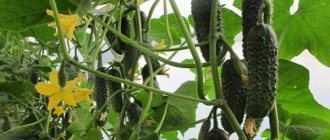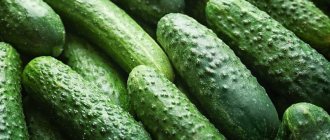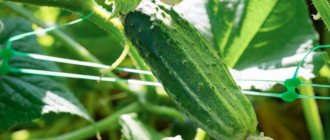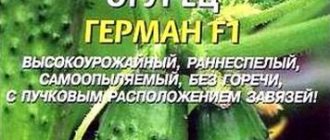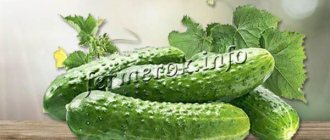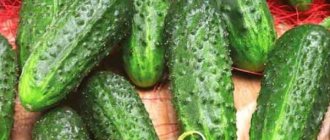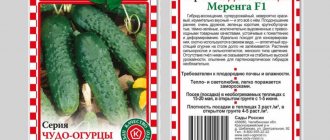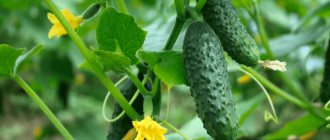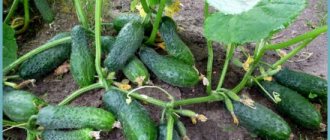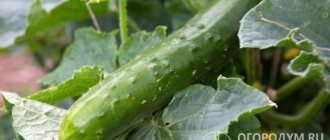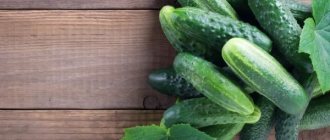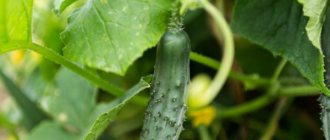Description of cucumbers Moscow evenings
Cucumber Podmoskovnie vechera f1 is a parthenocarpic hybrid, cultivated for more than 10 years. The variety was developed by Russian breeders in 2000. Cucumbers do not need pollination by insects, so they can be cultivated not only in open beds, but also in covered ones.
Moscow Evenings is a mid-season variety of crop, since cucumbers ripen 42-45 days after seed germination. The harvested crop is good fresh and is often used for canning, pickling and pickling.
Characteristics of the variety:
- Moscow Evenings f1 – indeterminate tall bushes: reach a length of 2-2.5 meters;
- Cucumbers are characterized by a female type of flowering, painted in a bright yellow color;
- Description of leaves: medium grade tops with wavy edges and small densely spaced thorns;
- Cucumbers reach a length of 15 cm and grow in an oblong oval shape;
- The skin of the gherkins is covered with sparse but raised tubercles with small white pubescence;
- Description of the pulp: cucumbers have a characteristic elastic, crispy, dense and not very juicy pulp;
- Taste characteristics: sweet, tasty and aromatic variety, without bitterness.
Some information about the plant and its fruits
The characteristics and description of the variety are as follows:
- The growing season of hybrid development from germination to full-fledged fruit lasts 42-45 days. The plant does not need to be pollinated.
- The height of the bush (main stem) is 1.5-2 m. Cucumbers of the described type have female flowers.
- Bundle ovaries are formed on the plant (from 1 to 3 pieces per node).
- Cucumbers are colored in dark shades of green. There are few tubercles on the surface of the fruit, but there are white-colored spines.
- Cucumbers weigh from 90 to 110 g, and the length of the fruit reaches 120-150 mm with a diameter of 30 mm.
Reviews from gardeners growing the hybrid show that the yield of cucumber products of the described variety is 13-16 kg of fruits per 1 m² of bed. Farmers note that the hybrid is resistant to most diseases characteristic of cucumbers. The plant bears fruit over a long period. Although most cucumbers like good lighting,
Evenings near Moscow easily tolerate a slight darkening. The crop is grown in open ground in the southern regions of Russia. The use of film greenhouses is typical for the central part of the country. In the Far North and Siberia, the hybrid is grown in greenhouse blocks equipped with heating systems.
Advantages and disadvantages of the variety
It is recommended to grow any crop only after becoming familiar with the advantages and disadvantages of cultivating fruits. In this regard, vegetable growers offer a list of positive characteristics of the hybrid Podmoskovnye Vecheri f1, a description of which is presented below.
pros
- High productivity of the variety: over 15 kg of cucumbers per 1 m2;
- Cucumbers have excellent taste characteristics;
- Cucumbers Podmoskovnye vechera f1 are famous for their resistance to growing in shaded areas and resistance to adverse weather conditions;
- Excellent external characteristics of the fruits of the variety;
- The hybrid Moscow Evenings does not require pollination by insects, which makes it possible to grow cucumbers in beds with film cover;
- Cucumbers are resistant to major infections;
- Long fruiting period of the variety;
- Cucumbers are versatile in use.
Minuses
The large number of advantages of cultivating the variety does not mean that cucumbers do not have disadvantages. Thus, vegetable growers identify two negative characteristics of the hybrid Podmoskovnye Vechery f1:
- Lack of cucumber seeds suitable for the next planting;
- Plants of the variety require regular watering.
Features of growing a hybrid
In order for the harvest to please, and the work not to be in vain, it is necessary to provide the crop with proper care. It is advisable to prepare a greenhouse, although the hybrid can also be successfully cultivated on open ground ridges.
Subtleties of sowing and caring for seedlings
In the southern regions, the stage of growing seedlings is skipped, sowing the seeds directly to a permanent place. In temperate climates with a short summer season, gardeners first grow seedlings, planting them in beds or in a greenhouse. It’s more hassle, but in return they get a supply of time, an early harvest of greens.
Prepare for seedlings:
- containers (pots, peat tablets, plastic or cardboard cups);
- substrate.
It is recommended to sow the crop immediately in separate pots, since seedlings after picking slow down their growth and take root worse. Sowing in separate containers allows you to avoid painful transplantation, and when planting in a permanent place, use the method of transshipment with a clod of earth, or plant seedlings together with peat pots.
Rules for planting seedlings
Planting is one of the main factors that subsequently influence the formation of ovaries and the development of the plant itself. Before planting, vegetable growers suggest that you familiarize yourself with the description of the features of planting Moscow Evenings f1.
Landing dates
It is recommended to plant cucumber seeds in mid-April in the northern regions and in the second half of March in the southern regions of the Russian Federation. In addition, experts advise paying attention to the temperature of the soil. So, planting seeds near Moscow evenings is carried out only after the soil has warmed up to 15-17 degrees Celsius.
Site preparation
It is recommended to plant the seeds of the variety in beds where tomatoes, potatoes, peppers, or cabbage were previously grown. It is not advisable to plant the crop in a place where zucchini, cucumbers, pumpkins or watermelons were cultivated.
Despite the shade tolerance of the variety, it is necessary to choose a site located on the sunny side, which is protected from the wind. Vegetable growers also recommend the expected acidity level of the soil in the beds - pH 6-7.
In the fall, future beds are dug up and fed with manure, compost, or wood ash. To reduce the acidity level, the soil is fed with chalk or slaked lime.
Planting seedlings
It is recommended to plant the seeds of Moscow Evenings f1 to a depth of 2-3 cm. The holes with cucumber seeds are sprinkled with soil and the soil is moistened with warm liquid. Afterwards, containers with future seedlings of the variety are placed in a well-heated room (temperature 27 degrees) and provided with lighting for up to 16 hours.
Cucumbers are transplanted into open beds after the bushes have formed 4-5 full leaves. The depth of planting of bushes is 5-7 cm. After planting, the plants are watered and shelter is created for the beds.
Planting scheme
The hybrid Podmoskovnye Evenings f1 is planted according to a 50 to 50 scheme. Such a planting scheme does not cause inconvenience during harvesting and does not impede the development of its neighbors.
Agricultural technology and care
In the spring, to warm the soil faster, cover it with film. The optimal soil temperature for growing the Podmoskovnye Vecheras variety should be at least +15°C. The planting location should be sunny or in partial shade. Before sowing, soak the seeds in a weak solution of potassium permanganate or boric acid (0.2 g of boric acid per 10 liters of water). To make the seeds germinate faster, wet the gauze and leave the planting material to hatch.
The originator advises sowing the seeds to a depth of 2-3 cm, in late April early May. Place 2-3 seeds in one hole. The first shoots from pecked seeds should appear on the 4th day. Water the plants in the late afternoon. Water consumption before flowering is 5-10 liters per 1 m², and during setting and fruiting 10-15 liters. The day after irrigation, loosen the beds.
Important!
Do not bury the hoe more than 2-4 cm, so as not to damage the root system of the cucumbers.
Keep weeds away. Grass attracts pests to the garden. Keep the beds clean. Vegetable bushes are strongly climbing and densely leafy. Remove side shoots to reduce stress on the plant. Form cucumbers into 2-3 stems. It is advisable to tie the vegetable crop to a trellis. Feed the plants at least twice. First, when 5 leaves appear, use Azofoska. The second time, during the flowering period. Fertilize with a nutrient solution based on potassium salt - 15 g, superphosphate - 15 g and 10 liters of warm water. Consumption per bush is 1 liter.
Care
To make cucumbers beautiful and tasty, it is recommended to regularly water the bushes near Moscow evenings f1, feed and hill up the soil, and form bushes. We suggest studying the description of all the necessary agrotechnical procedures for cultivating the hybrid Podmoskovnie Vechera.
Watering
Water the cucumber variety as the soil dries out: once every 3-4 days. In severe droughts, watering work is carried out more often. The irrigation liquid is infused in the sun, or heated independently to 25-27 degrees.
Watering procedures are especially important during the period of plant growth. Moscow evenings. At this point, the soil moisture level should reach 60-70%. During fruiting, the bushes of the variety need moistened soil of about 80%.
Garter and bush formation
The lashes of bushes near Moscow evenings must be tied to a vertical support. If cucumbers are grown in greenhouse conditions, the bushes form 1 stem.
Top dressing
It is necessary to apply fertilizing 2-3 times per season. The most effective soil fertilizer is manure. However, you cannot limit yourself to just this mineral. As a rule, cucumber bushes near Moscow evenings are fed with potassium and phosphorus components contained in superphosphate.
Characteristics of varieties Altaisky, Aprilsky, German
Cucumber Podmoskovnie vechery F1 belongs to the group of hybrids that are intended for cultivation in open areas and in film greenhouses. Used fresh for preparing salads and other dishes. Fruits can be transported to any distance. Some housewives salt and pickle them for the winter.
It is recommended to water the plants in the evening, after sunset. For this purpose, water heated by the sun's rays in a barrel is used. It is recommended to water the hybrid with plenty of liquid.
Feeding the bushes is carried out once every 8-10 days. First, nitrogen fertilizers are used. After flowers appear on the plants, fertilizing is carried out with potassium and phosphorus mixtures. When the first fruits form, it is recommended to switch the hybrid to fertilizing with mineral fertilizers.
- Designed by breeders for cultivation in open beds and in spring film greenhouses.
- Tolerates light shade well.
- The ripening period is mid-season - its growing season is 43-46 days.
- An indeterminate variety, that is, it has a highly developed main stem.
- The flowers are predominantly female.
- Pollination is not required for the ovary.
- The ovary is bundled, 1-3 pieces per node.
- High-yielding - produces 14-16 kg of fruit per 1 m² per season.
- Fruits for a long period.
- The variety is resistant to most known cucumber diseases.
Zelentsy hybrid Podmoskovnye Vechery F1 is dark green in color with sparsely spaced tubercles. The spines are whitish. The marketable ripe fruits are quite large - 90-110 g in weight and 12-15 cm in length. Very tasty in salads and in preparations.
First of all, gardeners who have already grown this cucumber note its ability not to reduce productivity in conditions of slight shading. The taste and aroma received a good rating. Cucumbers are very good in a salad or on their own.
Regardless of the method used to grow the Moscow Evenings F1 cucumber, the yield will always be very high and the taste will be excellent.
Attention! “Moscow Evenings f1” is a cucumber variety that can be grown in any region of the Russian Federation.
The hybrid belongs to the category of early ripening vegetable crops. From the moment of formation of full shoots, the vegetable crop enters the fruiting phase after about 42-45 days.
The variety is intended for spring-summer rotation. Among other features of the hybrid form it is worth noting:
- belonging to the parthenocarpic category;
- flowering is predominantly female;
- indeterminateness.
The hybrid is considered to be highly vining, canned, and salad. In 1 node of the plant, 1-3 flowers of the female type can be formed. The vegetable crop has wrinkled leaves. They are distinguished by slightly wavy or smooth edges. The leaf blades themselves are a rich green color. The “Moscow Evenings f1” variety is distinguished by massive fruit production.
Cucumber near Moscow evenings belongs to the hybrid early ripening garden crops of the indeterminate type. The variety can be used for spring and summer rotation, suitable for growing in small garden plots and large farms. The plant's unpretentiousness makes it suitable for use by beginning gardeners. Features of the variety include:
- belonging to a parthenocarpic species;
- female type of flowering;
- good fruit setting ability.
The plant has a good ability to form strong lashes. The leaves have a characteristic green color and wrinkled texture with slightly wavy or smooth edges. A characteristic feature of cucumber is the friendly yield of the harvest.
Cucumbers have good taste and aesthetic qualities. Reviews from gardeners indicate the possibility of using fresh fruits for salads and canning.
Cucumbers can be grown either by seedlings or without seedlings. They are hypersensitive to cold, and good seed germination depends on the soil temperature - it should be at least 14 ° C.
Cucumbers can be grown either by seedlings or by sowing directly into the ground. Cucumbers can be successfully grown on various types of soil with sufficient aeration and drainage, although they grow best on light soils rich in humus. The experience of many gardeners has shown that they respond well to the application of various organic fertilizers that improve the soil structure.
The seedling method of cultivation makes it possible to significantly accelerate fruiting. Thus, in open ground, the first harvest of cucumbers grown by seedlings can be obtained 2 weeks earlier than cucumbers grown in the usual way. At the time of planting, the plants should have 3-4 true leaves, that is, be 2-3 weeks old.
The seedling method of growing will significantly speed up fruiting. To grow cucumbers with seedlings you need:
- Take full-fledged large seeds that have undergone pre-sowing heating (to do this, you need to keep them for a month near heating devices at a temperature of about 25 ° C). Seeds heated in this way will produce the most vigorous shoots, the plants will begin to bear fruit earlier and will produce less barren flowers.
- Then the seeds need to be disinfected: for this you can use an infusion of garlic pulp - 30 g of garlic pulp per 100 g of water (cold). Keep the seeds in this infusion for an hour.
- After this, we put them in fabric bags and soak them for 12 hours in a nutrient solution: 1 liter of water, 1 teaspoon each. spoon of sifted wood ash and nitrophoska.
- Then, after rinsing with clean water, we place them on a slightly damp cloth and keep them at a temperature of 20 ° C for about 2 days until they are completely swollen. Make sure that the seeds do not germinate; they should only slightly sprouted.
- The last stage of pre-sowing treatment of cucumber seeds is to place them in the refrigerator for a day.
Remember: hybrid seeds do not need pre-sowing treatment.
Cucumber seeds are sown in small containers. Cucumber seeds are sown to obtain seedlings throughout April - in small containers about 10-12 cm high.
- A nutritious soil mixture must be prepared in advance: 1 part sawdust (we use small and old ones) 2 parts humus and peat. For 10 liters of this mixture add 1.5 tablespoons. spoons of nitrophoska and 2 table. spoons of wood ash.
- Having mixed the soil mixture well, fill the containers to the top with it, sow the sprouted seeds (one piece per container) and water them a little. The seedlings will be ready in 27-32 days.
- When the seedlings have 2 true leaves, they need to be fed with a special solution: mix 3 liters of warm (about 20 °C) water, 3 teaspoons. spoons of nitroammophoska or nitrophoska.
- Throughout the entire growing period, water the cucumber seedlings once a week, spilling the container completely.
The best soil would be a mixture: 1 part each of sawdust, humus, peat and turf soil (1:1:1:1). But, as we have already said, almost any land is suitable for growing cucumbers.
Almost any land is suitable for growing cucumbers. Having formed the beds, water them with a solution: 10 liters of hot (80 ° C. 90 ° C) water 1 teaspoon. spoon of copper sulfate, spend about 3 liters per 1 m², and leave for a day. On the day of planting cucumber seedlings or sowing seeds in the ridges, we make holes, the depth of which is about 4 cm, with a distance of about 60 cm from each other. We put the seeds in the holes, sprinkle soil on top and water them, and plant the seedlings vertically.
Cucumber care
Cucumber beds should always be free of weeds. During the first 3 weeks, while the plants are small, we carefully loosen the soil to a depth of 2-4 cm. In the future, loosening must be carried out at least once a week.
During growth and fruit formation, cucumbers need a lot of water. To obtain the highest yield, water using warm water: before flowering - every 6-8 days, during fruiting - every 3-4 days.
You cannot water cucumbers this way: the water should fall on the soil, not on the plants. If the water does not seep through well, use a pitchfork to make punctures between the rows; such loosening will not disturb the root system of the plants. You cannot water the cucumbers with a strong stream from a hose; you only need to water the soil, not the plants themselves.
Feeding cucumbers
If you grow cucumbers in a greenhouse, fertilizing must be done 5 times per season - with organic and mineral fertilizers.
Cucumbers need regular feeding
- For the first time, we feed the cucumbers at the beginning of their flowering with the following solution: add 1 teaspoon to 10 liters of water. a spoonful of urea, potassium sulfate and superphosphate, mix and add a glass of mushy mullein. Instead of a glass of mullein, you can take 1 table. spoon of sodium humate.
- During the fruiting period of cucumbers grown in open ground, they need to be fed about 4 times. We make the first feeding with a solution consisting of 10 liters of water, table. spoons of nitrophoska and a glass of mushy chicken droppings. And all subsequent ones are like this: add 1 teaspoon to 10 liters of water. a spoonful of potassium sulfate and 0.5 liters of mullein, 4-6 liters of solution will be needed per 1 m². If there is no droppings and mullein, they can be easily replaced with the compositions “Breadwinner”, “Fertility”, “Ideal” (all of which are natural humic fertilizers) or simply sodium humate.
Caring for cucumbers also involves tying up the shoots of the plant, which must be done regularly as they grow.
After the formation of 6-7 leaves, the main stem of the cucumber must be pinched, this will stimulate the branching of the plant and increase the yield.
Don’t forget about collecting fruits regularly (2-3 times a week), it will contribute to more abundant fruit formation.
There are more and more varieties and hybrids of cucumbers every year. At the same time, their composition is significantly updated every year - preference is given to the earliest, well-fruiting, and relatively resistant to various diseases.
Cucumber hybrids for open ground Remember that all F1 hybrids do not retain their unique properties in the second generation, that is, there is no point in collecting seeds.
A mid-season, productive, bee-pollinated hybrid with a predominantly female type of flowering, relatively cold-resistant, extremely resistant to powdery and downy mildew, as well as olive spot. 'Farmer F1' cucumbers are grown in protected and open ground. The green fruit reaches 12 cm. The peculiarity of this hybrid is the intensive growth of the main vine and the rapid appearance of lateral shoots, with the growth of which the peak of mass fruiting occurs.
Diseases and parasites
Moscow Evenings f1 is a hybrid variety that has strong immunity to mosaic, powdery mildew and olive spot. However, improper care and planting lead to infections, which are described below.
Downy mildew
Downy mildew or downy mildew is a disease that causes young leaves to become covered with spots and holes. Initially, spots with an oily consistency and a yellow tint form on the foliage.
Over time, the leaves become brown in color, and a gray coating forms on their back side. In addition, the infection also affects the cucumbers themselves: the fruits turn white and become tasteless. To combat infection, chemical preparations “Topaz”, “Ordan”, “Quadris”, “Khom” or “Oxychom” are used.
Root rot
Root rot is a pathology as a result of which the stems of a plant begin to darken, weaken, become soft and undergo cracking. In addition, during the daytime, cucumbers begin to fade, and at night they regain their previous appearance. To treat plants against disease, bushes near Moscow evenings are treated with the substances “Previkur”, “Glyokladin”, “Trichotsin” or “Fitosporin”.
White rot
White rot is a disease that causes the foliage to become covered with white spots that look like cotton wool, the affected parts of the plant become rotten and watery, and the tops of the plant begin to wither and die. To combat infection, the drugs “Fitosporin” and “Previkur” are used.
Pests, diseases and prevention
The hybrid is not afraid of cucumber mosaic, olive spot, and powdery mildew. Slightly less resistant to downy mildew. To protect against other fungi, the ground and bushes are treated with a solution of Fitosporin. Copper sulfate is effective against root rot, and Topaz is effective against white rot.
To repel insects, when planting, rows of cucumbers are interspersed with rows of onions or other strong-smelling crops. Treatment with soap solution, infusion of tobacco or onion peel, or insecticides will help against insects.
Sources:
https://zelenj.ru/ogurec-podmoskovnye-vechera-f1.html https://eteplica.ru/ovoshhi-v-teplicax/ogurcy-podmoskovnye-vechera.html https://repka.online/ovoshhi/ogurtsyi/ rannespelyi/podmoskovnyie-vechera-f1.html
General characteristics and description
Moscow Evenings F1 is a first generation hybrid. Ripening period is mid-early. The plant begins to bear fruit 42-45 days after the appearance of the first shoots. The vegetable crop belongs to the parthenocarpic type. The flowers produced are predominantly female. The bushes grow strongly climbing, the growth of the main stem is not limited. The leaves are dark green, heart-shaped, the surface is covered with small fibers, and the edges are wavy. Up to 3 cucumbers are tied under one leaf knot.
Features of the fruit
Cucumbers have a special taste that is preserved even when prepared. Description of fruits:
- young vegetables are dark green;
- there are rare tubercles on the surface;
- there are small white spines;
- the weight of a mature vegetable varies from 90 to 110 grams;
- The length of the fruit is from 12 to 15 cm.
The fruits have a dense, crunchy structure that does not contain voids.
Origin of the cucumber variety “Moscow Nights F1”
First you need to grow seedlings. The seeds are disinfected and then sown in boxes filled with soil. The seed is placed to a depth of 20 mm. After the sprouts appear, they are fed with organic fertilizers and watered with warm water. When the seedlings are 20 days old, they are transplanted to permanent beds. The sprouts should have 4-6 leaves. The hybrid planting pattern is 0.5x0.5 m.
The plant can be grown using the following means:
- Bags or plastic bags.
- Hut growing method.
- Use of inclined trellises.
In the first case, plastic bags with a volume of more than 100 liters or ordinary canvas bags are used. Prepared soil (peat, sand, humus) is poured into them. A stake 200 cm long is driven into the center of the container. Low plastic tubes are installed around it for watering the plants. 3 bushes are planted in each package or bag.
3 pegs are driven in around each improvised bed. A fishing line is pulled over them, and its free end is attached to a high stake driven into the middle of the bag. Relying on the fishing line, the plants will rise.
With the hut method of growing a hybrid, seedlings are planted in a circle, the diameter of which is 180-200 cm. A tall stake with hooks attached to it is driven into the center. A small peg is installed near each bush, on which one end of the fishing line is wound, and the other is tied to a hook on a pole. The plants cling to the fishing line with their tendrils and rise.
When using inclined trellises, the bushes are planted on narrow beds in 2 rows running parallel to each other. At the end and beginning of each row, high pegs are driven in. They are installed at an angle. All 4 pegs are connected by a long, horizontal strip, from which a stretched fishing line descends to each plant. The bushes are attached to it with mustaches and creep upward.
First you need to grow seedlings. The seeds are disinfected and then sown in boxes filled with soil. The seed is placed to a depth of 20 mm. After the sprouts appear, they are fed with organic fertilizers and watered with warm water. When the seedlings are 20 days old, they are transplanted to permanent beds. The sprouts should have 4-6 leaves. The hybrid planting pattern is 0.5x0.5 m.
It is important to note that this species is demanding on soil quality. Increased soil acidity can cause plant death.
“Zephyr F1” is a species suitable for growing in open ground. It involves pollination by plants. The fruits begin to appear on days 43-45. Their shape is elongated, and their weight reaches 100 g. The variety tolerates high humidity well and is resistant to powdery mildew. Therefore, it can be grown even in shaded areas.
But it is important not to forget that it is not highly resistant to low temperatures. Therefore, during frost periods it will be necessary to construct film shelters.
"Amur F1" is a hybrid variety of cucumbers that is self-pollinating and can tolerate high temperatures and drought. The fruits have a classic shape and color. The weight of vegetables reaches 90 g, and the length is 7-10 cm. This species has good resistance to fungal diseases. Plants bear fruit already at 45-47 days.
It is important to note that this variety is unpretentious to soil quality. However, it is important for it not to grow in the shade.
The best varieties of cucumbers for greenhouses in the Moscow region
In greenhouses you can grow both large juicy cucumbers and small crispy gherkins. Here are the best varieties for preservation, because under stable conditions they grow identical and beautiful.
Masha
A very productive early variety that can be harvested after 36 days. The fruits are small, a little prickly and slightly bitter, but they are ideal for canning and pickling.
Murashka
An excellent self-pollinating variety with short, lumpy salad fruits that are easy to recognize. In greenhouse conditions in the Moscow region, it is easy to collect up to 7 kg of cucumbers from a bush.
Benefit
Benefis fruits have a very expressive and fresh taste without any bitterness. The variety is resistant to fungus and rot, is completely unpretentious and is suitable even for beginners.
Elegant
An early greenhouse variety is best suited for salads, but is sometimes used for canning. Cucumbers are almost smooth, with small tubercles.
Kuzya
Another hybrid with small fruits that grow to a maximum of 9 cm. This is a classic salad variety and at the same time one of the best for canning.
Late varieties of cucumbers for the Moscow region
Late varieties ripen in 60 days or more. They are good because they just begin to bear fruit when everyone else has already finished.
Nezhinsky
The ancient variety does not lose popularity due to its tasty fruits and excellent commercial qualities. It bears fruit for a long time, is unpretentious in care and is resistant to drought.
droplet
A bee-pollinated variety of cucumbers with short vines and good yield - from 7 to 12 kg per square. The lumpy fruits are not too large, up to 120 g, with dense, juicy pulp without any bitterness at all.
Winner
The fruits of the Winner are easy to distinguish externally - they have an unusual light green hue and large thorns. The variety is resistant to drought and short frosts.
Unbearable
Another old variety that can be grown in all regions of Russia except the Southern ones. Even in open ground it bears fruit until the first frost.
Phoenix
Initially, this is a southern variety, but it has already proven itself well in the Moscow region. Its main advantage is its phenomenal keeping quality, due to which it is often grown for sale.
Reviews from gardeners
Aelita Stepanovna, 36 years old, Kursk region
The Moscow Evening cucumber variety was planted in open ground. The dacha plot is very small, so the cucumbers had to be planted near the trees. This did not affect fruiting in any way. The plants have grown powerful. She sowed the seeds in early May and began harvesting in mid-June. The fruits are tasty, but not very juicy, which is ideal for canning. During the entire season, the vegetable crop did not get sick even once, it was only attacked by whiteflies. The drug Tanrek was used against the pest.
